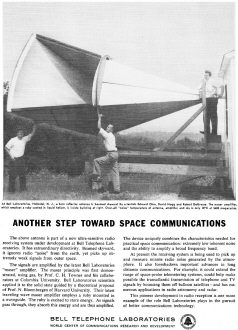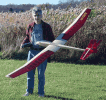|
November 1959 Radio-Electronics
 [Table of Contents] [Table of Contents]
Wax nostalgic about and learn from the history of early electronics.
See articles from Radio-Electronics,
published 1930-1988. All copyrights hereby acknowledged.
|
Little did the engineers
depicted in this Bell Telephone Laboratories advertisement in a 1959 issue of
Radio-Electronics magazine know the significance the "Sugar
Scoop Antenna" they were erecting at the time would play in the world of astrophysics.
Their intention, following the recently completed
International Geophysical
Year (IGY) efforts, was to design and build a system for characterizing the
Earth's atmosphere in preparation for satellite communications. A cutting-edge,
cryogenically-cooled ruby-based maser amplifier operated in the 5,600 MHz realm
with thermal noise in the 18K region. Undoubtedly lots of good information was gleaned,
but the most notable result from that antenna was the discovery in 1964 of the Cosmic
Microwave Background (CMB) radiation by Bell scientists Drs. Robert W. Wilson
and Arno A. Penzias. The pair was surveying the sky in the microwave spectrum and
noticed that regardless of where the antenna was pointed, there was always a fairly
constant level of "noise" that could not be removed from the system. It occurred
to them that they had stumbled upon the very electromagnetic signature of the early
post Big Bang universe. The rest, as the saying goes, is history.
Articles here on RF Cafe which mention the Dr. Robert W. Wilson and Dr. Arno
A. Penzias are
The Maser & Sugar Scoop Antenna: Receiver for Signals from Space,
Bell Telephone Laboratories Project Echo,
The Amazing Maser: The Jewel That Conquers Space,
Cosmic Radio Signals from Sun and Stars, and
Sugar-Scoop Antenna.
Bell Telephone Laboratories Ad
 At Bell Laboratories, Holmdel, N. J., a
horn reflector antenna is beamed skyward by scientists Edward Ohm, David Hogg and
Robert DeGrasse. The maser amplifier, which employs a ruby cooled in liquid helium,
is inside building at right. Over-all "noise" temperature of antenna, amplifier
and sky is only 18°K at 5600 megacycles. At Bell Laboratories, Holmdel, N. J., a
horn reflector antenna is beamed skyward by scientists Edward Ohm, David Hogg and
Robert DeGrasse. The maser amplifier, which employs a ruby cooled in liquid helium,
is inside building at right. Over-all "noise" temperature of antenna, amplifier
and sky is only 18°K at 5600 megacycles.
Another Step Toward Space Communications
The above antenna is part of a new ultra-sensitive radio receiving system under
development at Bell Telephone Laboratories. It has extraordinary directivity. Beamed
skyward, it ignores radio "noise" from the earth, yet picks up extremely weak signals
from outer space.
The signals are amplified by the latest Bell Laboratories "maser" amplifier.
The maser principle was first demonstrated, using gas, by Prof. C. H. Townes and
his collaborators at Columbia University. Bell Laboratories scientists applied it
to the solid state guided by a theoretical proposal of Prof. N. Bloembergen of Harvard
University. Their latest traveling wave maser amplifier employs a ruby mounted in
a waveguide. The ruby is excited to store energy. As signals pass through, they
absorb this energy and are thus amplified.
The device uniquely combines the characteristics needed for practical space communication:
extremely low inherent noise and the ability to amplify a broad frequency band.
At present the receiving system is being used to pick up and measure minute radio
noise generated by the atmosphere. It also foreshadows important advances in long
distance communications. For example, it could extend the range of space-probe telemetering
systems, could help make possible the transatlantic transmission of telephone and
TV signals by bouncing them off balloon satellites - and has numerous applications
in radio astronomy and radar.
This pioneer development in radio reception is one more example of the role Bell
Laboratories plays in the pursuit of better communications technology.
Bell Telephone Laboratories
World Center of Communications Research and Development
Posted August 2, 2022
|










